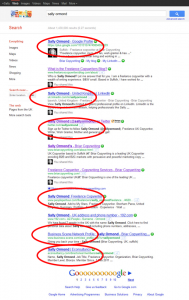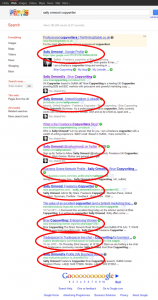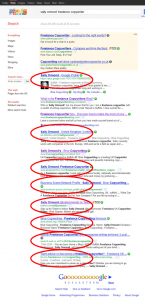Entries Tagged 'social media' ↓
November 18th, 2011 — LinkedIn, social media, social media marketing
All social media sites have their place and LinkedIn’s is right at the top of the professional networking tree.
You often hear stories of people being ‘found’ by prospective employers and being offered their dream job, all because of their LinkedIn profile.
So how can you make sure you stand out from the crowd?
Well, it’s all about getting noticed, so keep reading to find out how you can maximise your profile.
7 ways to boost your LinkedIn profile
There are 7 elements within your LinkedIn profile which must be maximised to make the most of your listing.
1. Headline
As with all sales and marketing, your headline is the very important.
You need to sum up, as succinctly as possible:
- Who you are
- Who you can help
- How you can help them
This will tell the reader everything they need to know in an instant and allow them to decide whether they want to read on or not.
2. Be real
It’s too tempting to be boring, business like and wooden in your profile.
Granted, people are going to want to know about you from a business perspective, but they also what to get to know the real you.
In your summary, show something about yourself – your goals, what you love doing, what makes you get out of bed in the morning. By offering a personal insight into who you are enables a connection at a personal level.
3. Spelling
This one always crops up in lists like this, mainly because it’s so important.
It doesn’t take long to proofread something, so make sure you go through your profile and spell check it. A typo or grammar gaff could cause you to be overlooked.
4. Call to action
One thing often overlooked in LinkedIn profiles is a call to action.
It’s something you automatically place within your copywriting, so why not add one here too?
After your profile has told them how great you are and what you can do for them, direct them to your website for more information or give them a phone number/email address so they can easily get in touch with you.
5. Proof
OK, so your profile shows you can talk the talk, but so you have any concrete proof to back everything up?
Make sure you detail your education background, any awards you have won as well as recommendations from past clients. All this evidence will help convince the reader that you’re the person they need.
6. SEO
Yes, you can search engine optimise your profile.
Make sure your keywords appear in your:
- Headline
- Current work experience
- Past work experience
- Summary
- Specialities
7. Be different
This one will make you stand out from the crowd. Try and be original when putting together your profile. Don’t stick to the normal description that will make you blend in. Think about what you can say that will make you different. Don’t just follow the crowd, try to put yourself across in a unique and memorable way.
Over to you
Have you had successes with your LinkedIn profile?
Did it land you your dream job?
Leave a comment below and let your experience help others.
November 16th, 2011 — facebook, social media, twitter
Using social media has become a part of our everyday lives.
Once upon a time, we would pick up the phone or pop round for coffee when we wanted to catch up or arrange outings.
Today, it’s a whole different ball game. You can maintain relationships through outlets such as Twitter and Facebook. But there is one major difference with the social media age compared with the ‘olden days.’
91% of employers use social media to screen applicants
When you post a comment on Facebook or send out a tweet, it’s not something that just disappears after your conversation has ended.
Before, you could say anything to anyone (within reason) and you could get away with it. Your private life and social life were completely separate from your employer. Unless you told them about the bender you went on at the weekend, they were unlikely to find out.
But, social media changes everything.
The rather sobering statistic above was recently reported by The Drum.
Because your status updates on your social media sites are there for all to see, they are an invaluable source to perspective employers.
Let’s face it, when in an interview situation, we all just tell the panel what they want to hear, so the impression they get of us isn’t always the whole truth. But now, by using social media channels such as Twitter, Facebook and LinkedIn, they will see the bigger picture. In fact (according to the Reppler survey):
- 47% of employers check social networking sites to screen prospective employees immediately after receiving their job application
- 69% have rejected a candidate based on something they saw
- 13% of candidates were rejected because they’d lied about their qualifications
- 11% were rejected because of posting inappropriate comments, inappropriate photos, posting negative comments about a previous employer or demonstrating poor communication skills
But before you head off and delete all your social media accounts, it’s not all bad.
68% were found to have employed someone because of what they saw about them on a social networking site, with a positive impression on their personality and organisational fit being at the top of the list.
The moral is…
Social media is great, but be careful what you post.
As the above shows, more and more employers can use these channels to dig below the surface and discover the type of person you really are.
So next time you are about to post in haste, stop and think about what you’re typing.
Sally Ormond – copywriter and social media addict
November 14th, 2011 — social media, social media marketing, social networking
 Networking online through social media sites is a great way to reach a worldwide audience.
Networking online through social media sites is a great way to reach a worldwide audience.
The only problem is, once you put something out onto the web it’s gone, but not forgotten as it will be there forever.
Therefore it is important to have a strategy in place before you start. After all, you don’t want to experience that sinking feeling – you know the one I mean. When was the last time you send a text to the wrong person and stood watching your phone helplessly because you couldn’t get it back?
To help you survive and thrive in the online world, here are 3 simple tips to help you avoid making too many bloopers along the way.
1. Strategy
Briefly touched on above, it is essential you have a strategy in place before you dabble in social media.
If you throw things out in to the ether willy-nilly it will have no effect whatsoever. So, before you get going make sure you:
- Know what the goal of your campaign is
- Who your campaign is aimed at
- What your audience want to know
- The actions you need to take to get results
2. No optimisation
The idea about social media and social networking is to boost your online visibility. But in order to be found, you must optimise your profiles.
That involves including your keywords in your biography.
3. Ignore feedback
Feedback, good and bad, must be dealt with.
Ignoring comments and messages is rather like sitting in your office and ignoring all calls and customers that walk through your door.
Social media opens up new channels through which your customers can interact with you. They will make use of your Twitter account and Facebook fan page. They will openly tell you what they think of your products and services (both the good and the bad) so it is essential you monitor these channels and deal with their feedback in a timely manner.
This is where your strategy comes into play. You must gave guidelines in place so your staff understand how to deal with positive and negative feedback to make sure you don’t end up with a PR disaster on your hands.
Over to you
Social networking is a great way to promote your business online, but it is essential you have a strategy in place.
How did you go about putting your strategy together?
Did you start out with one, or were you forced into it?
Leave your comments below and see if we can put together some best practice tips.
November 7th, 2011 — search engine optimisation, seo, SEO copywriter, social media, social media marketing, social networking
Have you ever wondered how some people end up everywhere on the web?
If you Google their name, reams and reams of listings appear. How do they do it? How do they make themselves so visible?
The answer is good old fashioned search engine optimisation.
If you’re thinking I’ve finally lost it because surely, SEO is surely just for websites, let me put your mind at ease. No, I haven’t completely lost it. SEO is just as important for your social media profiles as it is for your website.
The whole point about filling in your profile on sites such as Twitter, LinkedIn and all the other social networking sites, is to make yourself visible to potential clients or business partners. So if you’re not making the most of them, why bother?
To illustrate my point, after Googling ‘Sally Ormond’ the first page of search results alone show 6 social media/networking profiles.
So not only does my website and blog appear, but anyone searching for information about me will also see my name splattered all over the web with numerous profiles (and blog posts and articles) detailing all the great work I do for my clients.
That’s pretty powerful stuff.
OK, I hear what you’re saying – Sally Ormond is my name as opposed to a search term that I would optimise for.
So what if I amended my search to ‘Sally Ormond Copywriter’ or ‘Sally Ormond freelance copywriter’?
Well….


As you can see, in both cases even more social media sites appear.
So there you go – this is why it’s essential to make your profiles stand out. That doesn’t mean you have to cram them with your keywords. But make sure your keyword (which is probably your primary business activity) appears near the beginning of your description.
Filling the web with great information about you and what you can do for your clients is essential if you want to position yourself as an expert in your field.
After all, it’s becoming more common for people to Google other people so they can find out a bit about them. If nothing shows up (or very little), what does that tell them?
November 2nd, 2011 — Customer service, social media, twitter
 Despite the number of blog posts and articles you see about Twitter, I was flabbergasted to read a recent post on The Drum.
Despite the number of blog posts and articles you see about Twitter, I was flabbergasted to read a recent post on The Drum.
Apparently 71% of companies are still ignoring consumer complaints on Twitter.
Social media has opened up communications between consumer and business. Now, someone can complain through Twitter about poor service or product quality and within seconds potentially thousands of people will know about it.
And yet, there appear to be an alarming number of companies who are not monitoring Twitter effectively.
According to the article, in a survey by Maritz Research, only 29% of those who tweeted a company with a complaint received a reply. This shows a worrying trend – namely, businesses are still not ‘getting’ Twitter.
The post goes on to say that…
The American research looked at 1,298 consumers over the age of 18 who frequently tweet and have used the micro-blogging site to complain about a specific product, service, brand or company.
- 49% of respondents had expected the company to read their tweet
- 64.9% of older tweeters (aged 55+) expected a reply
- 38.4% of younger tweeters (18-24 year olds) expected a reply
Of those who received a response from a company, 34.7% were very satisfied and 39.7% were somewhat satisfied with the response.
While 86.4% said they would love/like it if the company had got back to them regarding their specific complaint, 63.3% said that they wouldn’t like or would hate it if the company contacted them about something other than their complaint.
The power of a tweet
Once upon a time, if a customer was unhappy about something they would pick up the phone and have a rant. But because they would be speaking with someone representing the company, in theory, their complaint wouldn’t go unnoticed.
But today, consumers have the ability to tweet their anger. Not only would this be directed at the company’s twitter name so (you would assume) they would get to hear about it and take action, it would also be seen by all their followers.
Whether companies like it or not, Twitter (and other social media channels) is the new ‘social telephone’.
The above research shows that most people (84%) liked it when companies got a response form their tweet. Just by listening, a company could greatly improve its customer service satisfaction levels.
Monitoring the noise
If a company is going to use social media, it must ensure it has the resources to use it effectively.
A Twitter account must be monitored to offer timely responses to customer queries and complaints. If you quickly make contact and resolve the issue, you can turn a potentially bad situation into a positive. Your customer will see you as a company that cares about its customers and listens to them.
Make sure your company isn’t one of the 71%:
- Monitor Twitter for any mention of your brand
- Respond quickly to tweets you receive from customers
- Never get into a Twitter argument
- A quick response will turn a bad situation into a positive outcome
Over to you
Does your business use Twitter?
How are you making sure you monitor it?
If you have any tips to share to help other businesses get to grips with the ‘social media telephone’, leave a comment below.
Sally Ormond – Freelance copywriter











